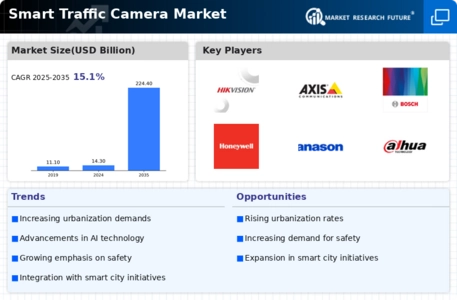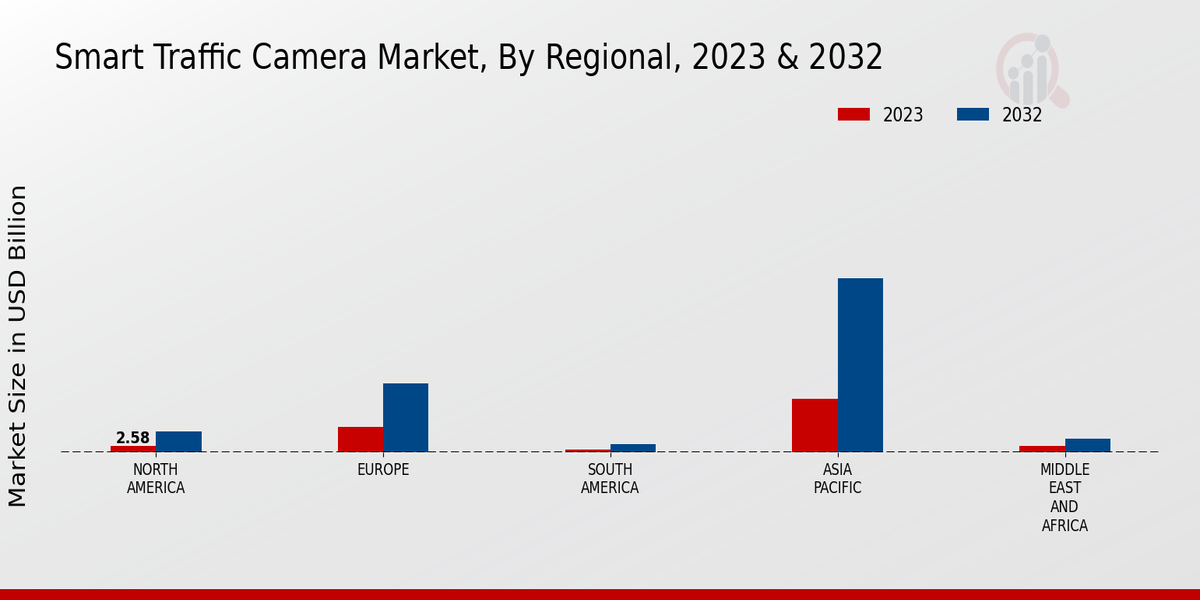Increasing Urbanization
The rapid pace of urbanization globally contributes significantly to the Global Smart Traffic Camera Market Industry. As cities expand, the need for efficient traffic management becomes paramount. Urban areas are projected to house 68 percent of the world's population by 2050, leading to increased vehicular congestion. Smart traffic cameras play a crucial role in monitoring traffic flow, reducing accidents, and enhancing road safety. This growing urban population is likely to drive the market, with the industry expected to reach 14.3 USD Billion in 2024, indicating a robust demand for advanced traffic management solutions.
Market Growth Projections
The Global Smart Traffic Camera Market Industry is poised for substantial growth, with projections indicating a market value of 14.3 USD Billion in 2024 and an impressive 224.4 USD Billion by 2035. This trajectory suggests a robust demand for smart traffic solutions, driven by various factors such as urbanization, government initiatives, and technological advancements. The anticipated compound annual growth rate of 28.44% from 2025 to 2035 further underscores the industry's potential. These figures reflect the increasing recognition of smart traffic cameras as essential tools for enhancing traffic management and road safety in urban environments.
Technological Advancements
The continuous evolution of technology significantly influences the Global Smart Traffic Camera Market Industry. Innovations in artificial intelligence, machine learning, and image processing enhance the capabilities of smart traffic cameras, enabling real-time data analysis and improved decision-making. These advancements allow for better traffic monitoring, accident detection, and enforcement of traffic regulations. As technology becomes more sophisticated, the demand for smart traffic cameras is likely to surge, contributing to a compound annual growth rate of 28.44% from 2025 to 2035. This growth reflects the industry's adaptation to emerging technologies and the increasing reliance on data-driven traffic management solutions.
Rising Road Safety Concerns
The growing awareness of road safety issues drives the demand for smart traffic cameras in the Global Smart Traffic Camera Market Industry. With increasing road traffic accidents, there is a pressing need for effective monitoring and enforcement mechanisms. Smart traffic cameras can capture violations, such as speeding and running red lights, thereby promoting safer driving behaviors. Countries are implementing stricter traffic laws and regulations, further bolstering the market. The emphasis on reducing fatalities and injuries on the roads is likely to propel the industry forward, as stakeholders seek reliable solutions to enhance road safety.
Government Initiatives and Funding
Governments worldwide are increasingly investing in smart city initiatives, which include the deployment of smart traffic cameras. These initiatives aim to enhance public safety and improve traffic management. For instance, various countries have allocated substantial budgets for smart infrastructure development. The Global Smart Traffic Camera Market Industry is likely to benefit from these investments, as governments recognize the importance of technology in reducing traffic-related incidents. With a projected market value of 224.4 USD Billion by 2035, the financial backing from government initiatives is expected to catalyze the adoption of smart traffic solutions.
Integration with Smart City Infrastructure
The integration of smart traffic cameras with broader smart city infrastructure is a key driver for the Global Smart Traffic Camera Market Industry. As cities adopt smart technologies, traffic management systems are increasingly interconnected with other urban services, such as public transportation and emergency response. This holistic approach enhances operational efficiency and improves the overall urban experience. The synergy between smart traffic cameras and other smart city components is expected to foster growth in the market, as cities strive for seamless connectivity and improved service delivery. This trend indicates a promising future for the industry as urban areas evolve.





















